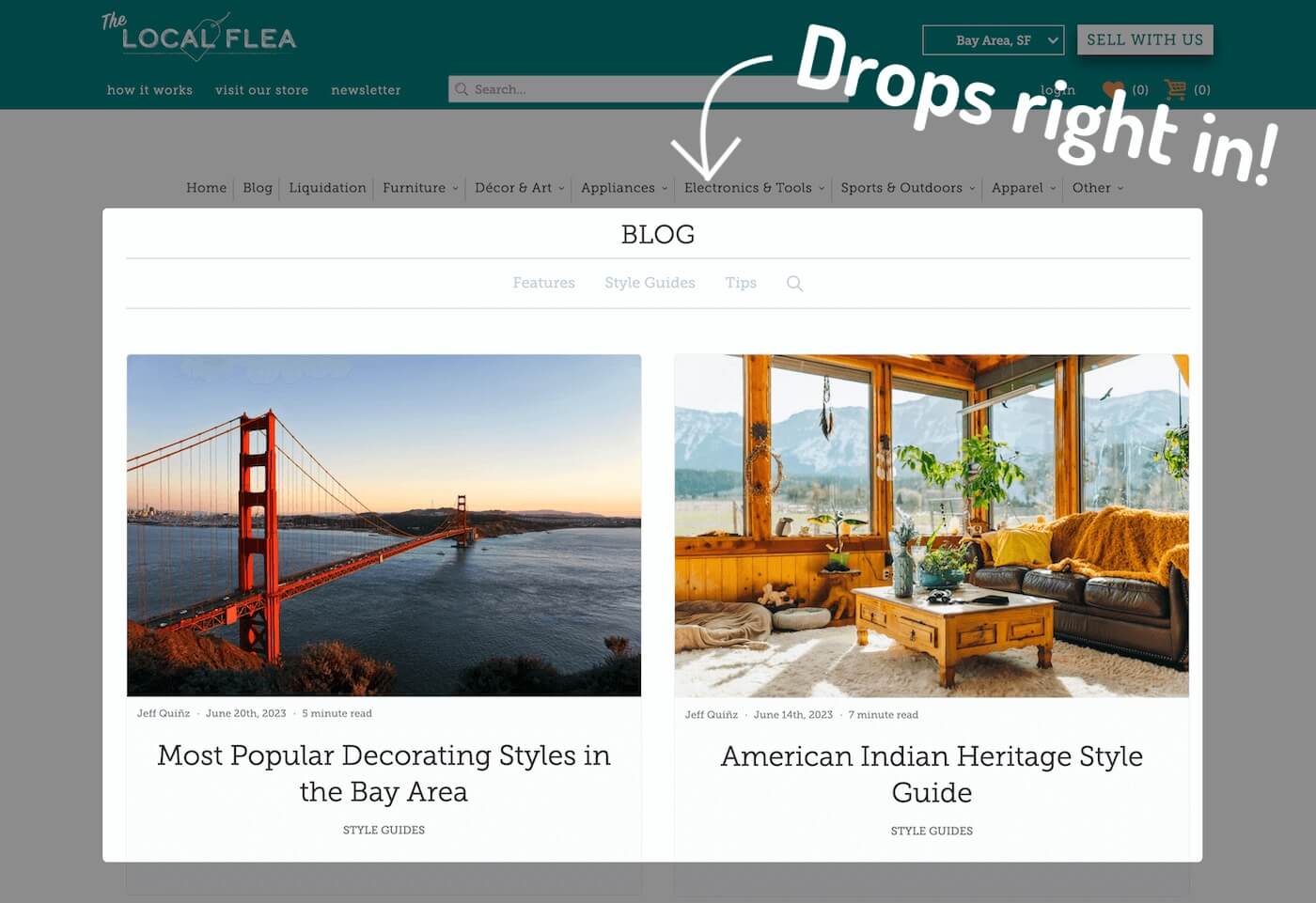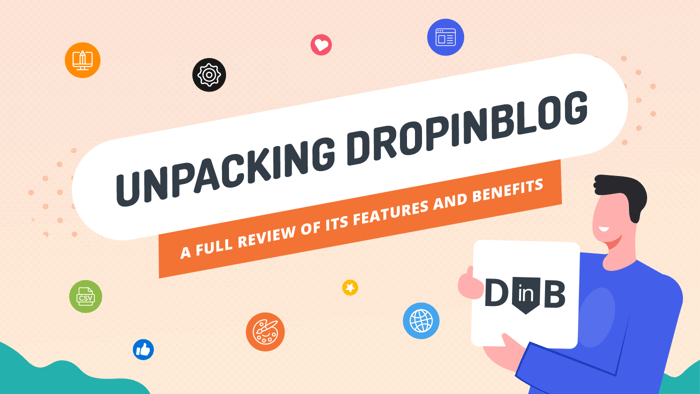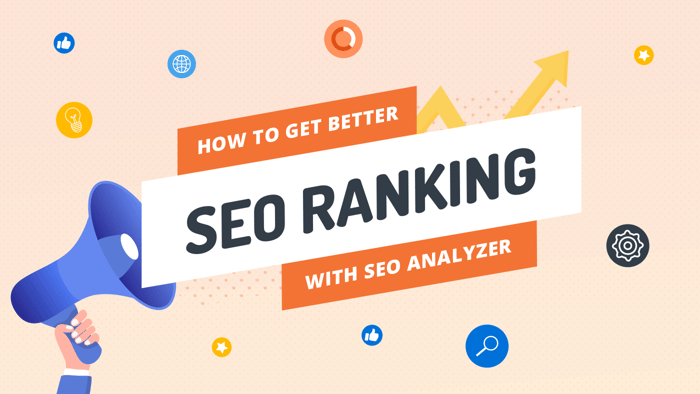Key Takeaways
- The best way to add a blog to your BigCommerce site is with DropInBlog!
- The free trial and quick setup lets you to test it in a few minutes.
- DropInBlog has different pricing plans for individuals and teams.
BigCommerce is a popular business platform and a powerful Shopify alternative. However, its built-in blogging tool doesn’t match the quality of its other features. So, in this tutorial, we’ll go over the steps of how to create a blog on BigCommerce with DropInBlog – a powerful, easy-to-use blogging tool. Let’s go!
Table of Contents
Summary
- You can create a blog on BigCommerce using the platform’s native blogging tool.
- The BigCommerce built-in blog only supports basic blogging features.
- If you’re looking for a more advanced blogging solution or want to add a second blog to your BigCommerce store, we’ll show you how to install the DropInBlog app in just three steps.
Can You Blog on BigCommerce?
Yes, you can blog on BigCommerce. Besides the blogging feature, the cloud-based e-commerce platform offers numerous built-in tools for SEO, product management, multi-channel selling, and more – so you don’t need dozens of third-party apps to run your store efficiently. The only real drawback? Its blogging functionality doesn’t match the rest of its features.
That’s where DropInBlog comes in.
How to Create a Blog on BigCommerce with DropInBlog
Okay, so let’s guide you through the steps of installing DropInBlog on your BigCommerce website.
Step 1: Install the DropInBlog App
To start the setup, go to the DropInBlog listing in the BigCommerce App Marketplace. Next, click Get this app to begin the installation process.
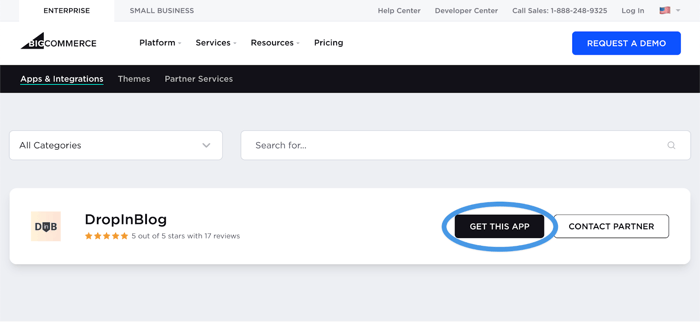
You will be redirected to a window asking you to log in to your BigCommerce account. To continue, click Log in.
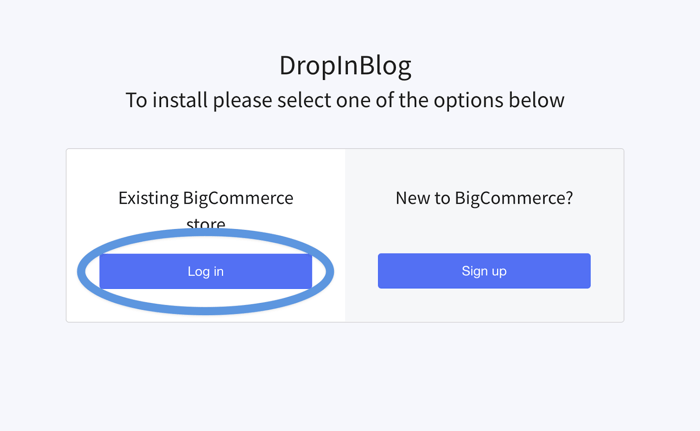
You will then be redirected to a sign-in form. After you enter your login credentials, you will be taken to a confirmation page within your BigCommerce dashboard. When you get there, click Install.
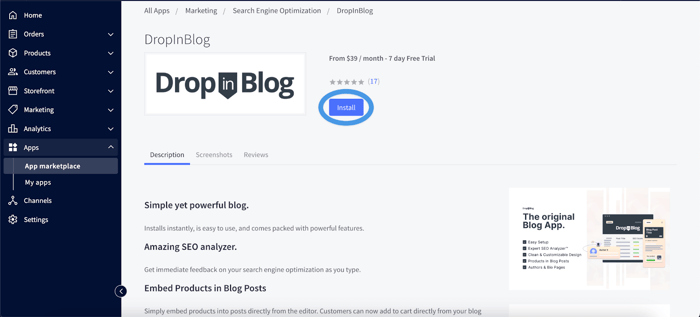
Next, you’ll be taken to a confirmation window where you need to click Confirm to finalize the installation process and allow DropInBlog to merge with BigCommerce.
And voilà! Your new DropInBlog account will be automatically created, and a DropInBlog page will be added to your website. You will be instantly redirected to your DropInBlog admin panel within the BigCommerce dashboard.
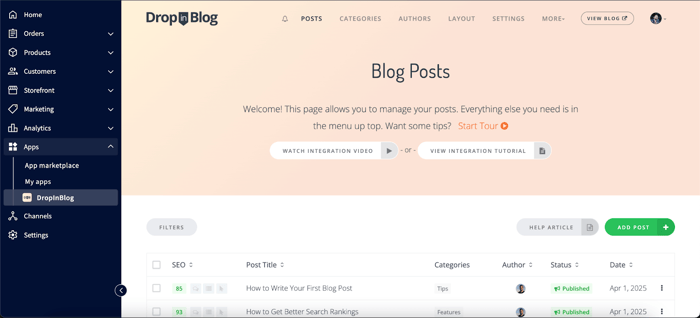
Step 2: Preview Your New Blog
You’ll notice that there are four example posts full of helpful tips, but we also recommend “taking the tour” to familiarize yourself with DropInBlog’s features.
To view how your BigCommerce blog page will look, you can click View Blog in the top right corner.
This is what we see when we preview our blog: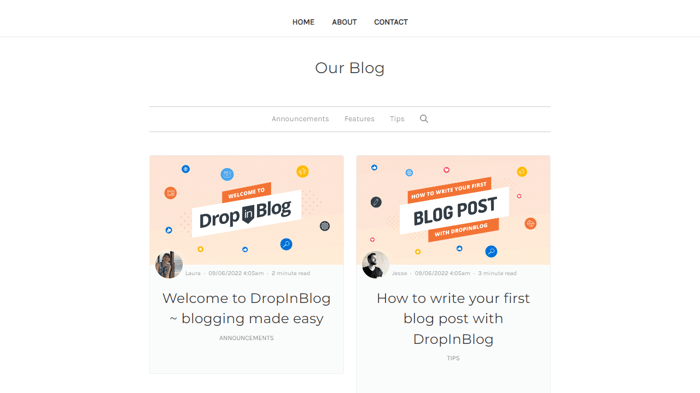
Step 3: Add the Blog to Your Menu
Head back to your BigCommerce dashboard and navigate to Storefront in the left navigation menu. After that, click Web Pages.
Here, you’ll see all the pages you have on your website. Toggle the visibility of Our Blog to “on” so that it will appear on the main menu. While you’re here, you can also arrange the order of your menu items.
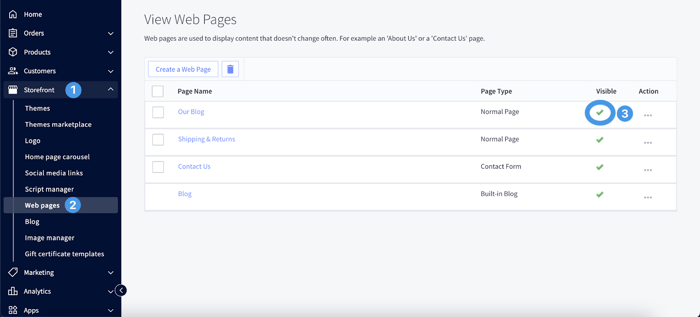
Lastly, when you want to manage your blog, navigate to Apps on your dashboard and click on DropInBlog. From here, you can add new blog posts, and edit the existing ones.
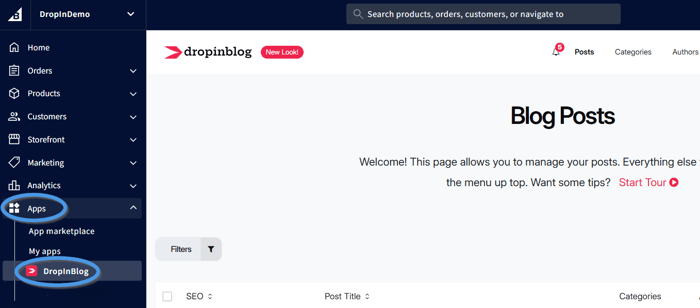
And that’s it! Now you can freely explore everything you can do with DropInBlog, the most practical blogging tool you’ll ever need!
How to Add Recent Posts to Your BigCommerce Homepage
For your blog to gain more visibility, you may want to add a section to the homepage of your BigCommerce site showcasing your recent blog posts. The video below walks you through the process step by step.
From within your BigCommerce account, navigate to Channels, and under Storefronts, select Edit theme.
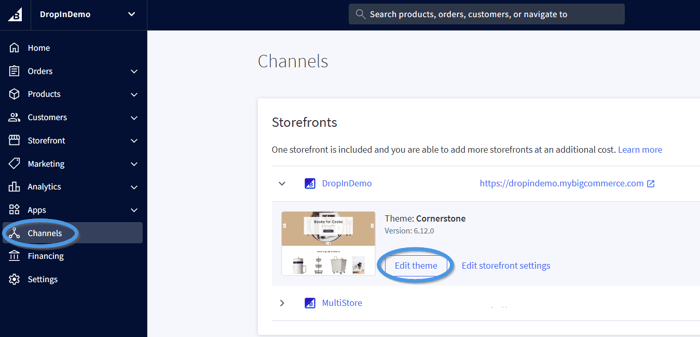
Next, on the left sidebar under Page Builder, find and choose Recent Posts – DropInBlog under the Custom section. Click and drag the Recent Posts – DropInBlog widget to the Drop widgets here section on your homepage.
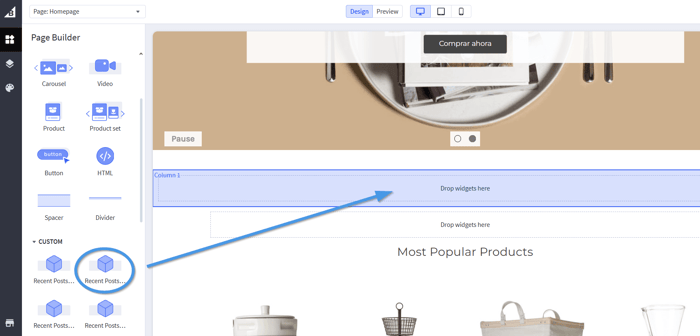
Once you've added it, the Recent Posts – DropInBlog section will appear on the left, where you can customize it by:
Changing the default title
Choosing the number of posts your visitors see when they land on the page
Editing the display layout
Selecting which post category shows in “Recent Posts”
Once you've done with the customization, click on Save to apply the changes, and then click on Publish to make your page go live.
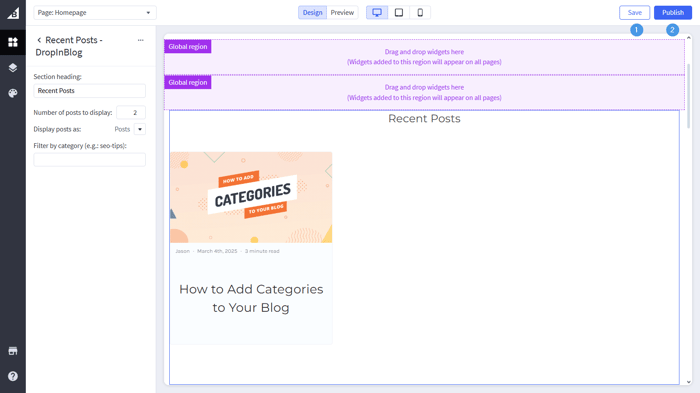
Finally, make sure to check it out on your live website!
Notable DropInBlog Features
Creating a super functional and good-looking blog with DropInBlog is easy, as you can see. But there’s so much more to blogging than just publishing articles, and DropInBlog has all the tools to elevate your blogging experience and optimize your posts.
Let’s briefly overview some of DIB’s notable features.
Blog Layout and Custom CSS
DropInBlog’s defining characteristic is that it inherits your CSS, which means your new blog will seamlessly adapt to your chosen website template. To further customize it, you can choose one of the three blog layouts. You’ll find them in your DropInBlog dashboard under Layout.
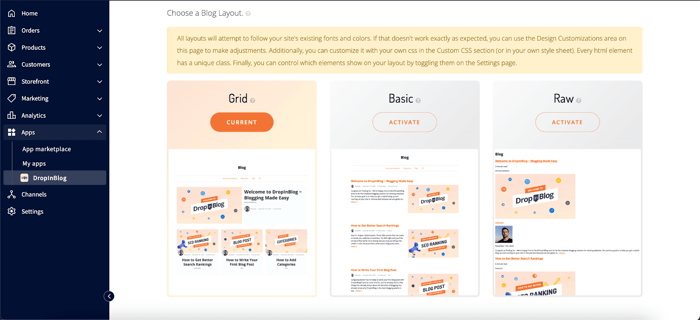
From here, you can also add custom CSS that will be injected into your website if you want to go a step further. You can use this to customize the appearance of your blog even more and implement highly specific changes.
SEO Analyzer
The SEO Analyzer is truly the highlight of DiB. It’s an intelligent, interactive tool that gives you immediate feedback as you type. It grades your content based on keyword usage, image SEO, and internal links, and suggests ways to improve your article's SEO score.
For instance, it will check whether your content has images with proper alternative text and whether you’ve included your primary keyword in the first paragraph and the article title. It displays green, orange, and red squares next to each criterion to help you easily discover how well your content has been optimized for search engines.
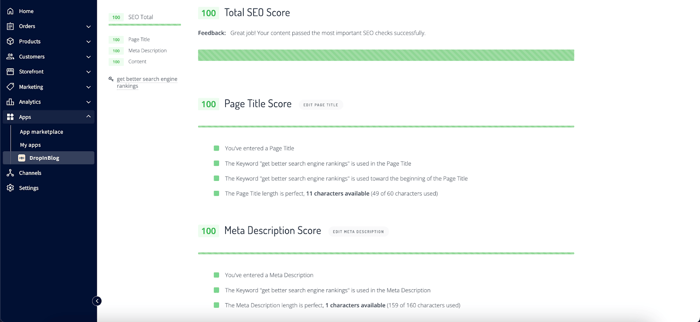
This is the gist of it, but for more in-depth information, you can check out our article on how to use the SEO Analyzer for better SERP results.
Blog Settings
With DropInBlog, you can manage your blog settings in great detail. From adding 404 error messages and article reading times, to modifying the output previews with just a toggle and changing the social and localization settings, DropInBlog is as hands-on as it gets.
So, the only thing remaining is to look for inspiration and use the DropInBlog tools in the best way possible!
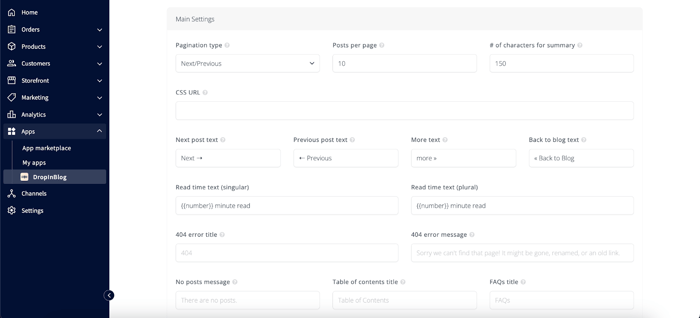
FAQs
Does BigCommerce allow you to start a blog?
Yes, BigCommerce includes a built-in blogging functionality. However, it’s limited if you want to do serious, regular blogging. If you want ease-of-use and quality SEO tools, you’ll be better off combining your BigCommerce site with a specialized blogging platform like DropInBlog.
Can I have two blogs on my BigCommerce website?
You can create multiple blogs on your BigCommerce store, but essentially, BigCommerce only allows one blog in the regular format. There are a couple of workarounds for creating multiple blogs on BigCommerce, and one is connecting an external blogging platform like DropinBlog.
Should I use the BigCommerce blog?
Yes, using the BigCommerce blog is a great way to engage customers and boost SEO. Install DropInBlog for an easy-to-use, customizable blogging solution that integrates seamlessly with BigCommerce.
Is there a BigCommerce blog plugin?
BigCommerce doesn’t have an official blog plugin, but you can use third-party integrations like DropInBlog for advanced features and customizations.
Start Blogging on BigCommerce Today
BigCommerce is an excellent platform, and DropInBlog complements it perfectly.
Thank you for choosing DropInBlog to be your blogging companion, and if you ever need help with anything or have a question, please don’t hesitate to contact us. We’ll be thrilled to assist you. Until next time, happy blogging!


